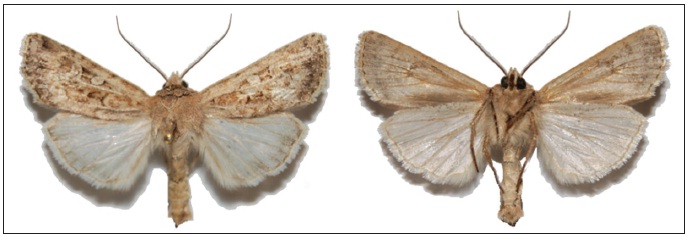Artículos
Agrotis desertorum Boisduval, 1840 new to the Maltese Islands (Lepidoptera: Noctuidae)
Agrotis desertorum Boisduval, 1840 nueva para Malta (Lepidoptera: Noctuidae)
Agrotis desertorum Boisduval, 1840 new to the Maltese Islands (Lepidoptera: Noctuidae)
SHILAP Revista de lepidopterología, vol. 46, núm. 183, pp. 501-503, 2018
Sociedad Hispano-Luso-Americana de Lepidopterología
Recepción: 04 Abril 2018
Aprobación: 21 Abril 2018
Publicación: 30 Septiembre 2018
Abstract: Agrotis desertorum Boisduval, 1840 is reported for the first time from the Maltese Islands. Distribution and habits of the adult are included. A Maltese name is proposed for this new record.
Keywords: Lepidoptera, Noctuidae, Agrotis, Agrotis desertorum, Maltese Islands.
Resumen: Se registra por primera vez para Malta a Agrotis desertorum Boisduval, 1840. Se incluye la distribución hábitos del adulto. Se propone un nombre maltés para este nuevo registro.
Palabras clave: Lepidoptera, Noctuidae, Agrotis, Agrotis desertorum, Malta.
Introduction
The genus Agrotis Ochsenheimer, 1816 is distributed throughtout all biogeographical regions with 80 species recorded from the Palearctic region (FIBIGER, 1990), 32 of which being present in Europe (FIBIGER, 1990). Normally Agrotis species are characterised by the strongly or moderately bipectinate antenna of the male and the ability to fly long distances. In normal jargon, larvae of Agrotis species are referred to as cutworms as some species are major agricultural pests whose larvae hide during the day and emerge at night to feed. The name cutworm refers to the habit of the larvae, of cutting down and partly eating garden and crop plant (SMIT, 1964).
In the Maltese Islands a total of 9 species within the Agrotis have been recorded so far: Agrotis lata Treischke, 1835, Agrotis puta (Hübner, [1803]), Agrotis herzogi Rebel, 1911, Agrotis ipsilon (Hufnagel, 1766), Agrotis trux (Hübner, [1824]), Agrotis segetum ([Denis & Schiffermüller], 1775), Agrotis spinifera (Hübner, [1808]), Agrotis haifae Staudinger, 1897, and Agrotis syricola Corti & Draudt, 1933 (FIBIGER et al., 2006). In Maltese literature, Agrotis obesa (Boisduval, 1829) and Agrotis exclamationis (Linnaeus, 1758) have been mentioned but never recorded (SAMMUT, 2000) so it is being assumed that these were erroneosuly mixed with Agrotis lata and Agrotis trux respectively due to their similarity.
Material
MALTA: 1 ♂, Zurrieq, 19-III-2018, at light, leg. J. Agius. (Fig. 1).
Distribution
Due to the very similar Agrotis ripae Hübner, [1823] the distribution within and outside Europe is uncertain but its type locality is south Russia. Their similarity is so close and the superficial variability is so high that for classification purposes A. desertorum has been grouped with A. ripae and A. alexandrensis Bethune-Baker, 1894. The so-called ripae species group has representatives both in Asia and Africa. (FIBIGER, 1997). However two recent records, one from Germany (GELBRECHT & WEISBACH, 2015) and one from Poland (NOWACKI et al., 1997), confirm that this species is rare but definitely not new to the European fauna.
Agrotis desertorum occurs along the sandy shores of rivers and lakes, by the sea and sandy ground in steppes.
Discussion
From the 17th till the 19th of March 2018, south westerly winds persisted over the Maltese Islands with an average wind speed of around 7.96 km/h and an average gust speed of 8.8km/h. During spring, southern winds are the typical weather over the Maltese islands and as usually happens, these winds bring a variety of North African species. In fact Autophila rosea (Staudinger, 1888), Heliothis nubigera (Herrich-Schäffer, 1851) and Hyles livornica (Esper, 1780) were also recorded during the same 3 days.
The species is new to the Maltese lepidopterofauna. I propose the Maltese name Agrotis taddesert, after a transliteration of the scientific name.

Figure 1
Agrotis desertorum Boisduval, 1840. Top: Upperside. Bottom: Underside.
Acknowledgments
To Dr Antonio Vives for the Spanish abstract.
BIBLIOGRAPHY
FIBIGER, M., 1990.– Noctuidae Europaeae. Noctuinae I, 1: 208 pp. Entomological Press, Søro.
FIBIGER, M., 1997.– Noctuidae Europaeae. Noctuidae III, 3: 418 pp. Entomological Press, Søro.
FIBIGER, M., SAMMUT, P., SEGUNA, A. & CATANIA, A., 2006.– Recent records of Noctuidae from Malta, with five species new to the European fauna, and a new subspecies.– Nota lepidopterologica, 29(1/2): 193-213
GELBRECHT, J. & WEISBACH, P., 2015.– Agrotis desertorum Boisduval, first discovered in Saxony in 1840 and thus also in Germany (Lepidoptera, Noctuidae).– Märkische Entomologische Nachrichten, 17(1): 65-68.
NOWACKI, J., PALKA, K. & SOSINSKI, J., 1997.– Agrotis desertorum Boisduval, 1840 - a noctuid new to the Polish fauna (Lepidoptera: Noctuidae).– Polskie Pismo Entomologiczne, 66: 121-124
SAMMUT, P., 2000.– Kullana Kulturali. 12 - Il-Lepidoptera: X + 246 pp. Pubblikazzjonijiet Indipendenza, Malta.
SMIT, B., 1964.– Insects in South Africa: How to Control them: XIV + 399 pp. Oxford University Press, Cape Town.
Notas de autor